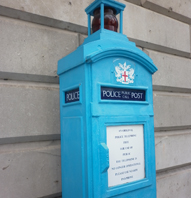British police forces have never made much use of their history – but a project to make something of the former Steelhouse Lane, Birmingham police station lock-up into a community museum could change that, writes Mark Rowe after hearing of the project at the West Midlands Police and Crime Commissioner’s business crime summit this week.
The West Midlands Police Museum makes perfect sense for two reasons. First, any police force has plenty of material. The Steelhouse Lane lock-up in Birmingham city centre has, I was told, records dating back to the 1830s and ‘mug-shots’ from the 1850s onwards – that is, the very dawn of photography. The project promises a room about Peaky Blinders, the popular BBC TV drama about the Birmingham gangsters of between the world wars. As a book by Birmingham Prof Carl Chinn shows, as reviewed in the January 2020 print issue of Professional Security magazine, the ‘Peaky Blinders’ were not smartly-dressed heroes, but self-interested thugs. But the success of the series proves the point – crime is wildly popular, and if you don’t provide the public with accurate and fair history, commerce will provide the public with something.
Second, the demand is there, if only police would make use of what they have. The Metropolitan Police, famously, dates from 1829 and the reforms of Sir Robert Peel; so many other police forces, beyond the UK, even, stem from that force. The ‘Black Museum’ housed at Scotland Yard was (see the atlasobscura website) part of the move to its new home on the Embankment, from Victoria Road, but is still not open to the public. A pity, because to name just one example, the murders of Jack the Ripper have spawned a veritable industry in the East End of London (and the City of London Police Museum is all over the Ripper). On the south bank of the Thames, there is The Clink Museum in Southwark.
Nottingham has the National Justice Museum. Otherwise, police forces, including West Midlands, may have collections of uniforms, truncheons and other police kit, paperwork, photos and objects generally that amount to a museum, that may not be in some basement but even displayed in a room that amounts to a museum, but is staffed by volunteers and only open occasionally. The police’s history is all around, and there’s more of it all the time – pictured is a ‘police post’ preserved in the City of London; consider that the Doctor Who Tardis is a police box. Yet police have simply made little of it.
In fairness to police forces, they do have a day job in the present; and some forces more than others have given their past paperwork and items to local government archives services – who have been struggling themselves to cope with public sector austerity of the 2010s. Outside the landmark London museums, museums in the regions have suffered. The picture is patchy. Which is only another way of saying that a project with enthusiasts can pick up grants and investment, and the time and effort of well-wishers.
The West Midlands project workers Corinne Brazier and Insp Steve Rice, besides enthusing themselves about what’s proposed, speak of the interest shown so far. Indeed, in any town, many people have personal or ancestral interest in their local police and its buildings – whether as a policeman, or a criminal locked up!
The lock-up project makes a fine case of how the museum – planned to open its doors by 2022 – can deliver police safety messages, and aid the tourist economy, besides the more traditional museum work of presenting history.
As for that word heritage, Steelhouse Lane is the oldest police building in Birmingham, a solid piece of Victorian city brick, outside and (as those of us who went in, while it was a working station) inside. Only the lock-up part of the station is to become the museum; the rest is part of the West Midlands’ force disposal of property, as done by many other forces, to save money and frankly to house people in more suitable, modern premises.
Who can resist wanting to feel of a wooden truncheon, or the chill of being locked inside a police cell? More profoundly, shouldn’t a visit to the police station, the fire station, the local magistrates court – if a town still has one thanks to austerity cuts – and, to get up to date, the council CCTV monitoring room, be a part of the civic education of every child? So that the next generation knows what its taxes are going on, that there are civic services that we may seldom see or require, but that we can rely on?
And as for the point that The Lock-Up in Steelhouse Lane is Victoriana and belongs to policing’s past; what are we as a society, if we do not know and appreciate our past?
The Lock-Up is looking for companies to partner, whether with money, equipment or staff through volunteering days. Or a company could sponsor specific events or work, such as youth group visits, outreach work, or themed exhibitions. Contact [email protected] to discuss. Visit https://www.wmpeelers.com/.










